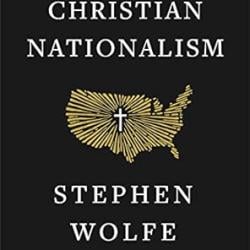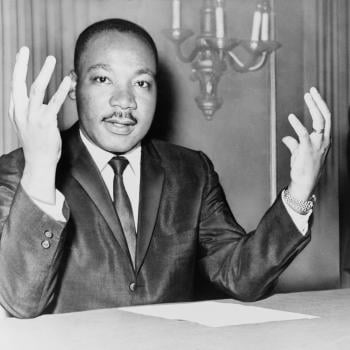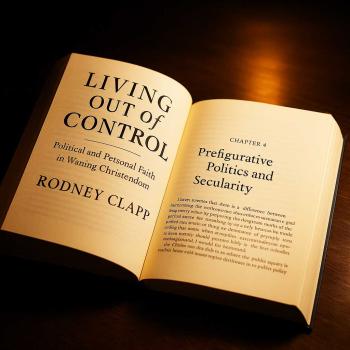A Possible Partial Explanation of the Contemporary Evangelical (Fundamentalist) Political Posture
I know that I am going way out on a limb here, attempting to explain, however partially, American fundamentalist evangelicals’ political support of President Trump and the Republican Party in general. The dots I connect here may not make much sense to anyone else, but I think I see connections between fundamentalist evangelicalism in the 1950s and 1960s and the seemingly irrational and uncritical political support of many fundamentalist evangelicals in the second decade of the 21st century.
The typical narrative put forward by, for example, noted scholar of evangelical history Randall Balmer is the hijacking of American evangelical Christianity for political purposes by cynical right-wing political hacks using abortion and homosexuality as their devices. This allegedly happened in the 1980s. I don’t deny that narrative; I only question whether it is thick enough to explain the phenomenon.
I grew up in the thick of American fundamentalist evangelicalism in the 1950s and 1960s. I suspect many observers, both inside and outside contemporary American evangelicalism, either are too young to remember or have forgotten one very strong emphasis of the American evangelicalism I grew up in. I am sure that emphasis was not unique to my church or denomination.
*Sidebar: The opinions expressed here are my own (or those of the guest writer); I do not speak for any other person, group or organization; nor do I imply that the opinions expressed here reflect those of any other person, group or organization unless I say so specifically. Before commenting read the entire post and the “Note to commenters” at its end.*
During the 1950s and 1960s American fundamentalist evangelicals were obsessed with an imminent “Tribulation Period” during which the world would be ruled by two men—the Antichrist and his false prophet. We were convinced that we were living in the lead up to that seven year Tribulation Period which would be followed by the bodily return of Jesus Christ to earth to defeat the Antichrist and his minions. We believed that true followers of Jesus Christ would be “raptured” (taken up) from the earth at the start of the Tribulation but would probably suffer tremendous persecution in the “last days” just before the rapture. And those “carnal Christians” who were not raptured would have to die martyrs’ deaths during the Tribulation in order to be saved.
Some of this narrative of the end of history as we know it is well-known today through the popularity of books by fundamentalist theologian Tim LaHaye. The books are known as the “Left Behind” series and some movies have been made based on the books. But LaHaye did not invent the narrative; it goes back at least to a British evangelical theologian named John Nelson Darby who was one of the founders of the Plymouth Brethren movement. He invented modern “dispensationalism” which is a method of interpreting the Bible that includes apocalyptic eschatology including the “secret rapture” before the “Tribulation Period” including the Antichrist, etc.
Darby’s apocalyptic eschatology was popularized by men like Clarence Larkin (Bible prophecy charts), C. I. Scofield (the Scofield Reference Bible), and later (1960s and 1970s) Hal Lindsey. It became a kind of unofficial orthodoxy among American fundamentalist evangelicals who were not Reformed (traditional Calvinist) although even some of them adopted it.
The key part of this dispensationalist, apocalyptic eschatology I want to bring out here is the expectation of harsh persecution of authentic Christians by governments just prior to the Great Tribulation Period and during it.
We were taught to expect persecution and even taught that lack of persecution was probably a sign that our Christianity was not authentic. We were taught and believed that in the “last days,” the “end times,” which we were entering, governments would criminalize true, authentic Christianity—even in America—and that we must be prepared even to die for being true, authentic Christians. We, in contrast with so-called “apocalyptic cults,” were not taught to arm ourselves or even to fight back when the persecution came. The mark of the true, authentic Christian was to be a steadfast witness in the face of persecution of any nature, including martyrdom, and not to resist with deadly force.
Some readers who are as old as I am will remember the bombshell book The Late, Great Planet Earth by Hal Lindsey. Fundamentalist evangelicals ate it up. Then came the film A Thief in the Night (1972) which portrayed the rapture and a few young Christians who were not raptured because they were not living a committed Christian life. The film was about how they had to die in order to be saved during the Great Tribulation. (I was at the world premier of the film. It went on to be shown in movie theaters and churches all around the world. You can see it on Youtube.)
When the Hollywood movie The Hiding Place—the story of Dutch Christian Corrie ten Boom’s life—was released in 1975 many American fundamentalist Christians, including yours truly, regarded it as a depiction of what lay ahead of us—persecution for being Christians. Ten Boom’s Christianity was displayed by hiding Jews during the Holocaust; ours would be displayed by being Christians in a world (including America) hostile to Christianity. We would be treated by governments, under the influence of the Antichrist, as Jews were treated by the Nazis in Europe.
When I was a high school kid there was a popular fad in fundamentalist Christian youth groups around America. I participated in this. Typically, the youth group would meet as usual but in a somewhat darkened room with heavy window coverings. The chairs would be placed in a circle and a “secret Bible study” would begin led by one of the older young Christians of the group. Suddenly, in the middle of the “secret Bible study,” a group of four or five older youths dressed in uniforms (purchased at the local army surplus store) would burst into the room with toy guns and “arrest” everyone. We would then be blindfolded and led away to “jail” to be “tortured” and made to accept the “mark of the beast” (666) on our foreheads. If we refused, we were told, we would be killed. This drama played out in hundreds, probably thousands, of churches and Christian youth groups throughout America and, I assume, the world in the 1960s.
This was all standard fundamentalist doctrine in the 1950s and 1960s in America and, I assume, elsewhere.
Is it possible that…as a result some fundamentalist Christians in the 1970s and beyond began to think it necessary to “take America back for Christ” through direct and indirect political action? Did they perhaps think they could alter the course of history as depicted in fundamentalist dispensational theology and keep Christians from being persecuted? Did they think they could prevent the Antichrist from taking over (at least) America? Did much of the energy that went into preparing fundamentalist Christians for the persecution that would come just before the rapture switch into preparing fundamentalist Christians to prevent that from happening—at least in America? I suspect that is at least part of the explanation for the rise of the so-called Religious Right and for the “culture wars.”
American fundamentalists had been politically neutral and uninvolved. Our ethic was D. L. Moody’s “lifeboat ethic”—not to change society but to get people saved and ready for the Second Coming of Christ if not the rapture. (It’s somewhat doubtful whether Moody himself ever actually accepted the idea of a “secret rapture.”) When I was a kid growing up in the fundamentalist evangelical subculture, politics was generally considered “worldly;” we prayed for leaders but did not vote. Or if we voted it was for whatever candidate would support our religious freedoms. (We really believed that John F. Kennedy would make the pope the ruler of America if elected president so we opposed him and most of us—I was just a child—did not grieve over his assassination. Those of us who voted did so for Nixon because he was not Kennedy.)
Suddenly, in the late 1970s and throughout the 1980s our own fundamentalist leaders became politically active and promoted not only voting for the “right” candidates but for campaigning for them. Who were the “right” candidates? Those who would support (our) Christian causes but more importantly protect us from persecution by the anti-Christian “left.”
What lay in the deep background of the seemingly sudden switch from political neutrality to passionate political activism—among American fundamentalist evangelicals? Well, yes, Roe v. Wade had something to do with it. The growing acceptance of homosexuality as normal had something to do with it. (Does anyone remember Anita Bryant?) But I suspect in the deep background was a readiness to “take America back for Christ” to hold back the Antichrist—at least here, in America. America would once again, as in the days of the Puritans, become the one place on earth where the Antichrist could not get a strong enough foothold to put Christians in concentration camps just for being Christians. I’m talking about a kind of unconscious influence, not a conscious thought process. In other words, the fear of persecution and being “left behind” created by fundamentalist apocalypticism in the 1950s and 1960s (does anyone else remember the song “I Wish We’d All Been Ready”?) led indirectly, if not directly, to fundamentalist political engagement in the late 1970s and 1980s (and beyond).
So—bottom line—why do so many fundamentalist evangelical American Christians support a leader who seems to live a life so contrary to Christian morality and who seems almost uniquely unqualified to be the leader of the “free world?” Could it be because they think, rightly or wrongly, that he would prevent their persecution and begin to turn what they see as the tide of anti-Christian “left-wing” national government in their favor? Did they put the “face” of the Antichrist over the face of the alternative candidate because she represented—to them—a political platform hostile to what they regard as authentic Christianity? Did they forget that we were taught—in the 1950s and 1960s—that the Antichrist would be a great deceiver winning over millions of Christians to himself before turning against the “faithful remnant” of true Christians? No, they didn’t forget. They just thought those deceived “Christians” were those “nominal Christians” in the mainline Protestant churches and that they, the true Christians, saw her for what she really was. But what if they were wrong and it is they who are the willing victims of a “great deception?” (All this—final paragraph—contains code language only fundamentalist Christians will understand. The rest of you might be able to figure it out, but probably not without a course in fundamentalist, dispensationalist theology.)
*Note to commenters: This blog is not a discussion board; please respond with a question or comment only to me. If you do not share my evangelical Christian perspective (very broadly defined), feel free to ask a question for clarification, but know that this is not a space for debating incommensurate perspectives/worldviews. In any case, know that there is no guarantee that your question or comment will be posted by the moderator or answered by the writer. If you hope for your question or comment to appear here and be answered or responded to, make sure it is civil, respectful, and “on topic.” Do not comment if you have not read the entire post and do not misrepresent what it says. Keep any comment (including questions) to minimal length; do not post essays, sermons or testimonies here. Do not post links to internet sites here. This is a space for expressions of the blogger’s (or guest writers’) opinions and constructive dialogue among evangelical Christians (very broadly defined).













